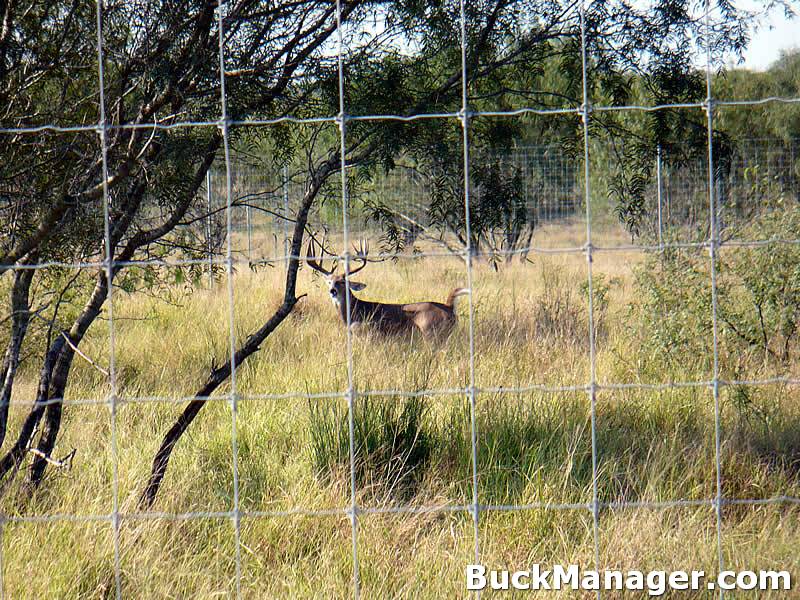They have become a part of the Texas landscape. Landowners that have them claim that they are critical for white-tailed deer management. Those that don’t either dislike them or simply can not afford them. Some people, hunters included, hate them. Hard working men make a living building them. “They” are high fences, often referred to as game fences. Like it or not, it seems high fences are here to stay, but a question that has undoubtedly crossed the minds of many deer hunters is, “What impact does a high fence have on the movement of white-tailed deer?”
Game fences are typically 8 or 10 feet in height, so there are high fences and then really high fences. Ask just about anyone and they will tell you that high fences are deer proof—deer inside the fence can’t get out and deer outside the fence can’t get in. This belief is disturbing to hunters and landowners bordering high fenced properties because it seems more and more ranches are turning to boundary fence that consist of high fence. I can see both the pros and cons of high game fences, but neither of them is so compelling that I want to drink to the proverbial Kool-Aid. That being said, high fences make it much easier to manage a deer herd.

If high fences were banned then deer and habitat management would still take place. However, the fact is in many states, including Texas, that high fences are legal. As such, game fences are just another tool that a landowner can choose to use or not to use in their individual deer management program. So whether you love them or simply love to hate them, let’s take a look at some of the latest research regarding how high fences impact the movement of white-tailed deer.
A study in South Texas headed up by Texas AgriLife Research is interested in determining the home range of deer both inside and outside a high fenced area. To collect the necessary data on deer movements, researchers placed GPS collars on three does and three bucks inside and three does and three bucks outside a 500 acre high fenced area. Collars collected location data every three hours for each deer for an entire year. So what did the first year of the study find?
This may surprise many of you, but researchers found that the home range sizes of collared bucks were similar on both sides of the high fence. Both groups of bucks, both inside and outside, had home range sizes of about 300 acres. Does, however, within the high fenced pasture tended to have smaller home ranges (185 acres) than those of does outside (285 acres) the high fence. These results lead to the conclusion that high fences restrict the home range of does, but do not necessarily effect the home range of bucks.
Although I would not have guessed this initially, the results of the first year of this study make sense. Both males and females of many wildlife species tend to be quite territorial, but the home range of males usually includes at least parts of the home ranges of several females. Does tend to be quite protective of their fawns and family groups much of the year, while bucks tend to me more complacent with other bucks over the bulk of the year. It would be interesting to compare the home ranges for bucks inside and bucks outside the high fence during the rut period.
These home range findings are interesting, but here is something that was identified over the course of the year that many of you will probably find most interesting. In fact, it may make you think a little differently about deer management and high fences. Remember the part about high fences being deer proof? Well, it turns out that they are not. Over 40% of the collared deer moved in and out of the high fenced pastures fairly regularly, presumably through holes created by feral hogs. This may be the case in some instances, but let’s not forget that deer can jump, too. Either way, researchers found that both bucks and does were capable of passing through a high fence, possibly eliminating potential deer overpopulation. Now that is something to think about.
Wow… 40% go through a high fence? That’s a lot. I’ve seen young bucks jump 8 foot fences flat-footed and I’ve seen does dart seemingly in between where the top and bottom links meet. Big feral boars can make massive holes that you can fit a 4-wheeler through. Heavier gauge wire on the lower 4 feet can stop that. Very informative about the home ranges… I can share at deer camp.
It’s not the 40% of the deer that are getting in and out… what are the numbers of people (poachers) that are getting in?
I agree about the article on deer fences. The fence acts as only a temporary deterrent or slow down point for the majority of deer. Not a fence that will keep them out (or in) as a due diligent deer will get through, or around one way or the other. To a deer the other side is always greener.
I have witnessed deer and other animals that while approaching a fence, that have nothing else to do but to figure it out to get around, over or through to the other side. It’s a deer’s job. As an avid deer hunter and gardener, I fall asleep each night counting deer jumping over my garden fence.
From my experience it seems white-tailed deer will only stay within a high fence if they want to. We have several hundred acres of thick, wooded deer habitat with a high fence around it. I’ve seen bucks that I recognize from game camera outside the fence and then days later they are back in.